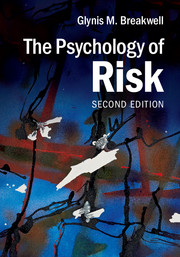Book contents
- Frontmatter
- Dedication
- Contents
- List of figures
- List of boxes
- Preface to the second edition
- Acknowledgements
- 1 A social psychological framework for analysing risk
- 2 Hazard perception
- 3 Individual and group differences in risk perception
- 4 Decision-making about risks
- 5 Risk and emotion
- 6 Risk communication
- 7 Errors and accidents; emergencies and disasters
- 8 Risk management; risk in complex systems
- 9 Social amplification, social representations and identity processes
- 10 Changing risk reactions: lessons from the psychology of risk
- References
- Index
9 - Social amplification, social representations and identity processes
Published online by Cambridge University Press: 05 October 2014
- Frontmatter
- Dedication
- Contents
- List of figures
- List of boxes
- Preface to the second edition
- Acknowledgements
- 1 A social psychological framework for analysing risk
- 2 Hazard perception
- 3 Individual and group differences in risk perception
- 4 Decision-making about risks
- 5 Risk and emotion
- 6 Risk communication
- 7 Errors and accidents; emergencies and disasters
- 8 Risk management; risk in complex systems
- 9 Social amplification, social representations and identity processes
- 10 Changing risk reactions: lessons from the psychology of risk
- References
- Index
Summary
Chapter preview
This chapter introduces a systematic way to conceptualise how risk events, through social and psychological processes, can be amplified, or indeed dampened, and as a result can lead to a ripple of different consequences at various levels (for instance, economic, legal, cultural). This conceptual approach is known as the Social Amplification of Risk Framework (SARF). The basic tenets of SARF are described and the ways in which it has been used are summarised. Some of the recent elaborations of the approach are presented. The layering method is outlined as a tool for exploring amplification processes and ripple effects. The significance of hazard sequences, templates and negotiations with amplification and ripple processes are outlined, using the 2008 financial crisis to illustrate the complexity of such processes. The chapter then proceeds to consider two theories that serve to explain some of the processes that underpin the amplification or attenuation of risk: Social Representations Theory and Identity Process Theory. Both theories are presented briefly and their usefulness in predicting risk perceptions and judgements and the ripple effects of risk events is suggested.
The Social Amplification of Risk Framework
The Social Amplification of Risk Framework (SARF) describes both the social and individual factors that act to amplify or attenuate perceptions of risk and then generate secondary effects such as regulatory changes, economic losses or stigmatisation of technologies. The SARF was first proposed in 1988 by Roger Kasperson, Ortwin Renn, Paul Slovic, Halina Brown, Jacques Emel, Robert Goble, Jeanne Kasperson and Samuel Ratick and has been subsequently elaborated (Kasperson et al., 1988; Renn, 1991; Kasperson, 1992; Burns et al., 1993; Kasperson and Kasperson, 1996; Kasperson et al., 2003). The idea arose, according to Kasperson et al. (2003: 13), ‘out of an attempt to overcome the fragmented nature of risk perception and risk communication research by developing an integrative theoretical framework capable of accounting for findings from a wide range of studies’, including those from the psychometric and cultural schools of risk research and those from the media and organisational dynamics research traditions. Rosa (2003) argues that SARF is the most comprehensive tool available for the study of risk.
- Type
- Chapter
- Information
- The Psychology of Risk , pp. 254 - 296Publisher: Cambridge University PressPrint publication year: 2014
- 1
- Cited by



